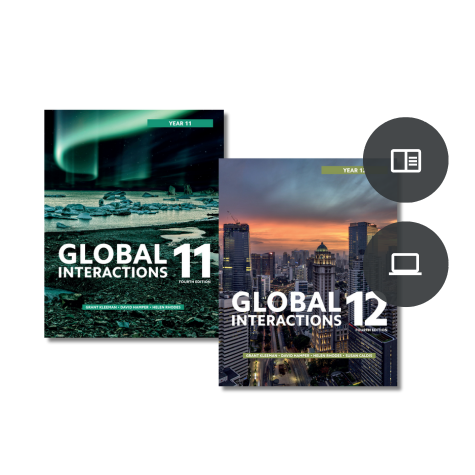Overview
Pearson's expert team have authored new editions of the award-winning series for the new Geography 11–12 Syllabus (2022) to be taught from 2024.
-
Year Levels 11–12
-
Curriculum NSW
-
Subject Humanities
-
Resource Formats Print, Digital
-
Learning Focus Geography
-
Last Updated Dec 2023
What it is
The new fourth edition of the award-winning Global Interactions series for Year 11 and Year 12 delivers content, statistics and case studies to cover all aspects of the new Geography 11–12 Syllabus (2022). It includes:
- engaging student books designed to help learners succeed
- accompanying eBooks that can be used both online and offline
- teacher resources that streamline lesson planning and exam preparation.
What it includes
Discover how the fourth edition of the Global Interactions series improves teaching outcomes for the new NSW Syllabus (2022).
What's new
Syllabus-defined content (2022)
The fourth edition of the Global Interactions series will support teachers to deliver the syllabus-defined content to Year 11 and Year 12 students. The fourth edition includes updates to:
- all content, in line with the substantive changes to the syllabus
- the structure and wording of headings throughout to ensure easy navigation and explicit links between the content and syllabus dot points
- comprehension question sets embedded with geographical tools and skills, to allow students to practise thinking and working geographically while developing an understanding of the stimulus material included.
What's new
Contemporary stimulus material
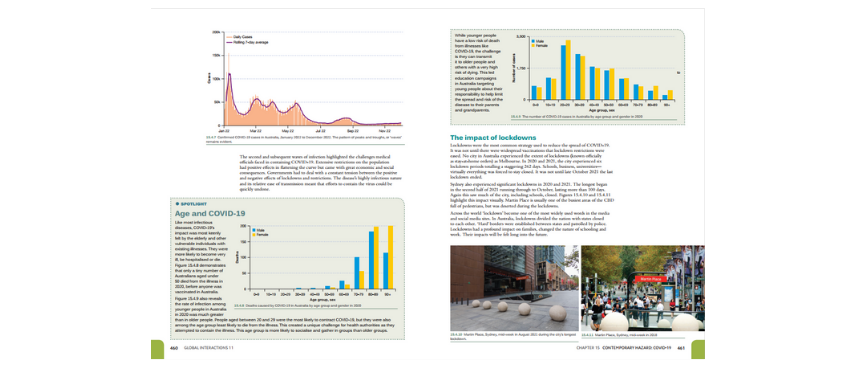
New stimulus material ensures the fourth edition resources are relevant and appealing to contemporary students and teachers. This includes updates to:
- topics
- case studies
- statistics
- imagery.
Every chapter explores the content through examples of the big issues in our contemporary world, including the effects of climate change, contested space in the South China Sea, COVID-19, the war in Ukraine, bushfires, and examples of global sustainability and biodiversity. Extensive case study chapters cover a range of the most popular ‘option’ topics in the new sylllabus, as voted by teachers.
For Year 11 the case study chapters include:
- Deforestation
- Glaciers and ice sheets
- Desertification
- Place and Political change
- Political power and contested spaces
- Human resilience in diverse environments
- Climate change
- Contemporary hazard: Bushfires
- Contemporary hazard: COVID-19.
For Year 12 the case study chapters include:
- Global tourism and its sustainability
- Global winemaking and its sustainability
- Rural place: Tamworth, NSW
- Urban place: Darling Harbour and the Bays precinct, NSW
- Large city outside Australia: New York City
- Large city outside Australia: Mumbai
- Ecosystem study: Great Barrier Reef, QLD
- Ecosystem study: Fjordlands of New Zealand.
What's new
Chapter glossary
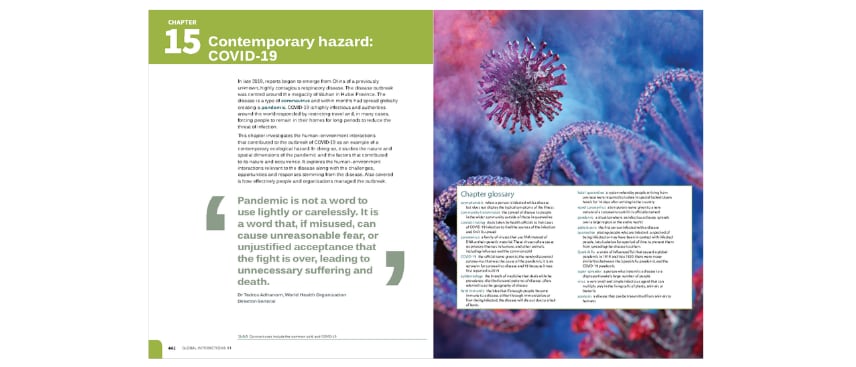
In the fourth edition, the chapter glossaries are now positioned at the front of each chapter, allowing students to familiarise themselves with key terms before progressing with the chapter content.
The glossaries provide an easy reference for more than 350 key terms, which are identified throughout the chapter content with bold text.
Extended glossaries are included for chapters requiring greater vocabulary support for students.
Components
Student Books
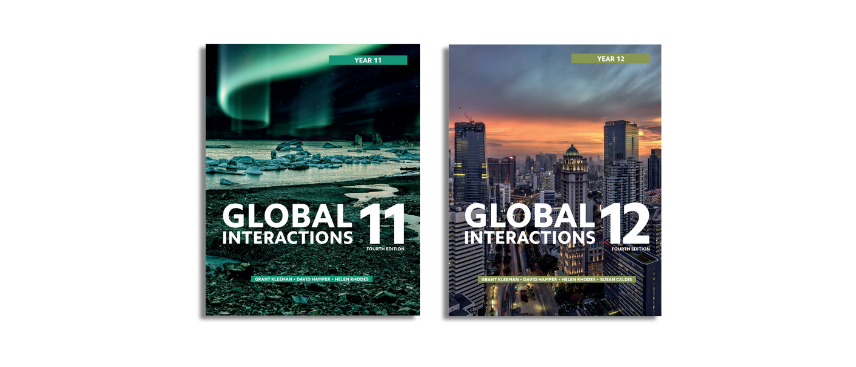
Developed specifically for the Geography 11–12 Syllabus (2022), the Global Interactions Student Books offer:
- a fresh layout with updated case studies and statistics
- dynamic and relevant images
- textual examples
- engaging graphs and maps.
Components
eBooks
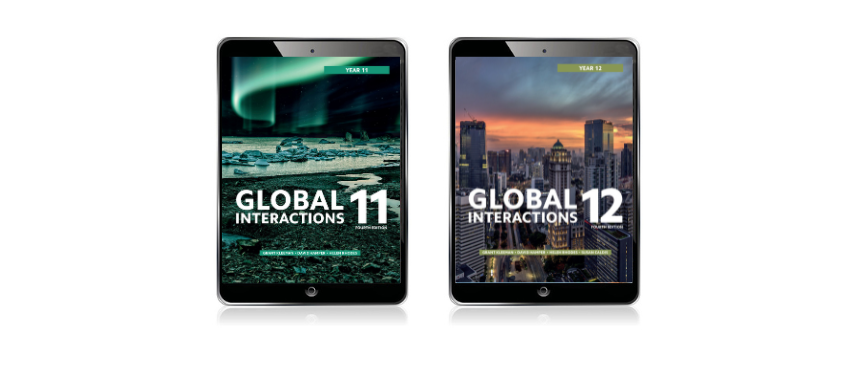
The electronic versions of the Global Interactions Student Books help students access:
- coursework on any device, online or offline
- digtal toolkit of resources and downloadable worksheets and interactive activities to support understanding of key geographical skills, including graphs, maps and statistics.
Components
Teacher support
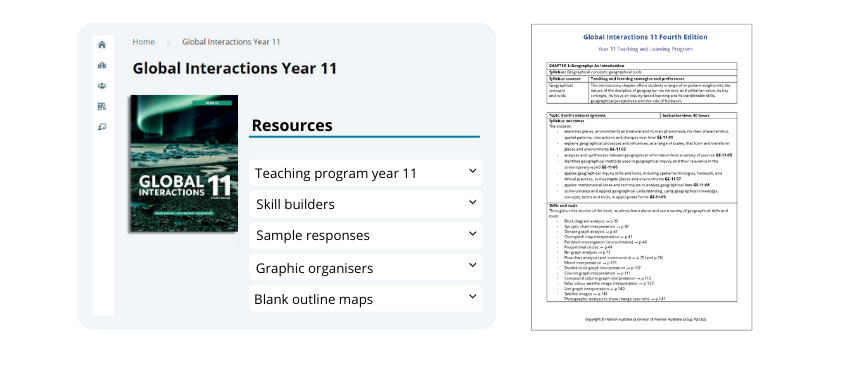
Global Interactions provides educators with access to support materials to enrich the content and save time, including:
- a teaching and learning program, which maps the resource content page by page against the syllabus dot points and offers teaching and learning programming for the knowledge, skills and tools of the new syllabus
- support for teachers via a digital toolkit for students that offers activities to develop a strong understanding of key geographical skills, including graphs, maps and statistics
- sample responses with differentiated and constructed answers to help students develop the skills required for exam preparation, provided in the Year 12 resources.
The Year 11 teaching and learning program is double the size of the program in the previous edition of Global Interactions. This 32-page program maps the resource content page by page against the syllabus dot points, offers teaching and learning programming for the knowledge, skills and tools of the new syllabus.
Series overview
Year 11 - Table of contents
Global Interactions 11 Fourth Edition has been written for the new Year 11 syllabus, to be taught from Term 1, 2024. The resources will be available in December 2023.
Table of contents: Global Interactions 11 Fourth Edition
- Chapter 1: Geography: An introduction
Section 1: Earth's natural systems
- Chapter 2: The uniqueness and diversity of Earth
- Chapter 3: Earth's natural systems at work
- Chapter 4: Land cover change
- Chapter 5: Deforestation
- Chapter 6: Glaciers and ice sheets
- Chapter G1: Desertification (DIGITAL-ONLY chapter)
Section 2: People, patterns and processes
- Chapter 7: Human activity on Earth
- Chapter 8: Our increasingly integrated world
- Chapter 9: Population and resource consumption
- Chapter 10: Place and cultural change
- Chapter 11: Political power and contested spaces
- Chapter G2: Human resilience in diverse environments (DIGITAL-ONLY chapter)
Section 3: Human–environment interactions
- Chapter 12: Changes to Earth's natural systems
- Chapter 13: Climate change
- Chapter 14: Contemporary hazard: Bushfires
- Chapter 15: Contemporary hazard: COVID-19
Section 4: Geographical investigation
- Chapter 16: Contemporary geographical inquiry
- Chapter 17: Undertaking geographical investigation
Series overview
Year 12 - Table of contents
Global Interactions 12 Fourth Edition has been written for the new Year 12 syllabus, to be taught from Term 4, 2024. The resources will be available in September 2024.
Table of contents: Global Interactions 12 Fourth Edition
-
Chapter 1: Geography in the contemporary world
Section 1: Global sustainability
- Chapter 2: Sustainability in the contemporary world
- Chapter 3: Global tourism and its sustainability
- Chapter 4: Global winemaking and its sustainability
- Chapter 5: Global energy production and its sustainability
Section 2: Rural and urban places
- Chapter 6: Rural and urban settlement
- Chapter 7: Rural place: Tamworth, NSW
- Chapter 8: Urban place: Darling Harbour and the Bays precinct
- Chapter 9: Large city outside Australia: New York City
- Chapter 10: Large city outside Australia: Mumbai
Section 3: Ecosystems and global biodiversity
- Chapter 11: Ecosystems and biodiversity
- Chapter 12: Ecosystems study: Great Barrier Reef
- Chapter 13: Ecosystems study: Fiordlands of New Zealand
Meet the authors
Global Interactions is brought to you by experienced educators who know New South Wales schools, the new syllabus and have all contributed to several geography texts including the Pearson Geography NSW series.
Grant Kleeman is an experienced teacher educator, geography teacher, author, curriculum consultant and examiner. Grant has been closely involved in the development of the geography curriculum at the state and national level for at least 30 years. He is the coordinating author of more than 50 texts, including the Pearson Geography NSW series.
David Hamper is an experienced geography educator and is currently Deputy Principal at Hills Grammar School, Sydney. David has also contributed to several geography texts including the Pearson Geography NSW series.
Helen Rhodes is an experienced geography educator and is currently a Master Assisting in Geography at Shore, North Sydney. Helen has also contributed to several geography texts including the Pearson Geography NSW series.
Susan Caldis is an experienced geography educator and is currently a lecturer in the School of Education at Macquarie University. Susan’s research focuses on curriculum and pedagogy. She has contributed to the Pearson Geography NSW series.
Samples & downloads
Global Interactions 11 Fourth Edition has been written for the new Year 11 syllabus, to be taught from Term 1, 2024. The resources will be available in December 2023.
- Global Interactions Year 11, 4th Edition – Teaching and Learning Program Sample Download PDF (107KB)
- Global Interactions Year 11, 4th Edition — Table of Contents Download PDF (269KB)
- Global Interactions Year 11, 4th Edition — Chapter 4 Sample Pages Download PDF (1.2MB)
- Global Interactions Year 11, 4th Edition — Chapter 6 Sample Pages Download PDF (1.3MB)
Global Interactions 12 Fourth Edition has been written for the new Year 12 syllabus, to be taught from Term 4, 2024. The resources will be available in September 2024.
- Global Interactions Year 12, 4th Edition – Table of Contents Download PDF (589KB)
You might also be interested in
Secondary Teaching Hub Geography 7–8
Aligned to the Australian Curriculum 9.0- Transition smoothly between curriculums with seamless curriculum alignment.
- Quality in all the formats you need with digital, print and downloadable options.
- Limit the stress of lesson planning with content filters and recommended lesson sequences.
- Understand and support the whole class with robust progress tracking and teacher support.
- Say goodbye to admin headaches with integrations to trusted tech platforms including Microsoft Teams and Google Classroom.

